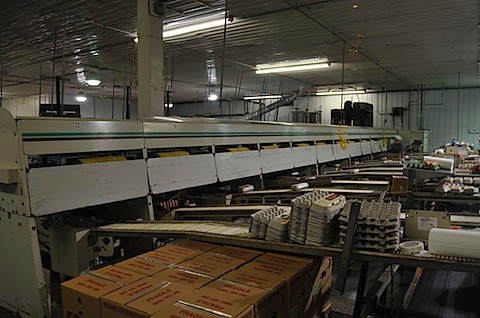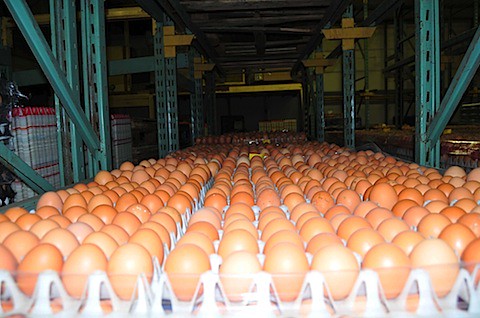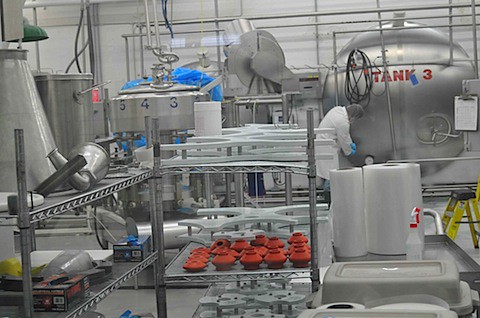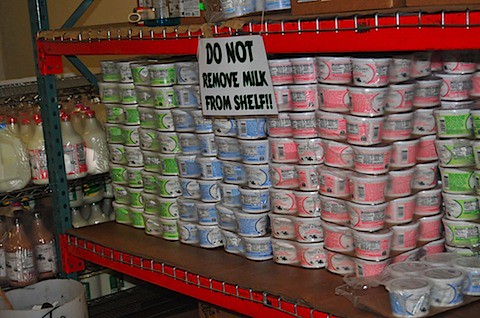Food Tour of Iowa: Kalona Organics
Because I went to driving school in LA, I was not taught certain driving skills that might be important in other parts of the country. I don’t really know how to drive on snow, nor do I know the etiquette about passing an Amish farmer who is in a horse and buggy. Do I tailgate? Do I pass? It’s things like this that they really should teach you. Anyway, I would have appreciated that lesson when I drove into the heart of Amish farm country today to visit the Farmer’s Henhouse (FHH) and creamery (FANC) in Kalona, Iowa, right outside Iowa City.
I met up with Joanna, my young, cheerful and knowledgeable guide at 3 o’clock at the Farmers All-Natural Creamery (FANC). While not an employee of FANC, she works with a group called Kalona Organics, who work as a marketing consulting group for small organic farmers in the area. They help represent the farmers and their cooperatives to distributors and retailers, and also provide branding aid. Joanna in her role as marketing director develops new products, designs labels and helps the farmers craft products that her colleagues can easily sell to consumers.
She had thoughtfully put together a set of visits to expose me to some of Kalona Organics clients: FANC and FHH, two cooperatives for the local dairy farms and egg producers, respectively, which Kalona then represents to distributors and grocery stores. In addition, I was going to visit one of the Mennonite dairy farmers from which FANC gets their milk. So I hopped into Joanna’s truck and headed off to FHH to learn how eggs are processed.
When we arrived Mark Miller, the owner and creator of FHH, greeted us. He bought the factory in 2000, and has since managed to expand both its sales and size substantially, with the branding help of Kalona Organics. He ushered Joanna and I inside to give us a tour of what they do in an egg processing plant.
The processing of eggs is fairly minimal. The eggs are offloaded from the local farmers into the plant, where they are first washed to remove any dirt. During this process, a watchful bearded man removes cracked eggs.


Afterwards, an automatic boxer puts the eggs into flats, which are then packed and labeled. 
From the FHH, the eggs go anywhere from California to Florida. Today, Mark’s factory uses about 20 employees each day, most of which are Amish children from the surrounding farms. He processes about 1,300 cases daily, with each case containing 30 dozen eggs. This breaks down into 39,000 dozen eggs per day; quite a number. He has managed to increase the amount sold per year by about 17% for the past 5 years, quite a significant growth factor. He attributes this to increased consumer awareness of organic, cage free eggs.

A bit of labeling background: eggs can be labeled “cage-free”, “free range” or “organic”. Cage free, in general, is not much better than caged. Free-range means the chicken can roam around a yard, and eat whatever they want in that yard. Organic eggs are from free-range birds on completely organic premises. Organic eggs are what one wants to look out for when shopping.
While not all of the farmers Mark gets his eggs from are organically certified yet, all of them have only free-range chickens. Joanna noted that studies have shown that free-range chicken eggs, organic or not, have been shown to be significantly better for you. The difference, she said, can even be seen: the yolk of a organic chicken which has had a varied diet is a brilliant golden yellow, compared to the drag yellow of a factory chicken egg. This translates into eggs with more “good” cholesterol and increased levels of omega-3 acids, which are good for you.
Part of Joanna’s job as marketing director is to research the health benefits of the naturally produced and minimally processed foods produced by clients of Kalona organics, as well as to help their clients implement practices that reduce processing.
While we were unable to go into the creamery processing area due to health restrictions, Joanna showed me the machinery through the window while talking about the benefits of FANC’s processing (or lack thereof). The creamery uses a special type of vat pasteurization, in which the milk is only heated to 145 degrees (compared to over 200 for most milk) for a longer period of time to kill germs. However, it also reduces shelf life from 60 to 15 days: in effect, FANC products sacrifice durability and convenience for flavor and nutrition. She had Iowa State University do a study about the chemical differences between FANC milk and regular milk: theirs had significantly higher levels of linoleic acid, as well as a much higher proportion of “active” enzymes (the same type you would find in yogurt). She attributes these health benefits to the milks minimal processing and low heat pasteurization process, as well as the work of the dairy farmers: most feed their cows only grass, as opposed to corn feed.

In addition, the milk tasted better. FANC produces “cream on top” milk: it is not homogenized, and therefore must be shaken to distribute the cream into the milk. As I tasted it, it did taste better than normal milk. It had a sweeter taste, and was creamy without being buttery, even compared against other milks of the same fat content. Joanna informed me that anecdotally many lactose intolerant customers had said that they could drink FANC milk: another benefit to their low impact processing policies.
Having examined the stunningly space age looking processing equipment, we went into a conference room so that I could sample some of the goods produced by FANC. IN addition to the milk, she also brought out some sour cream, low fat cottage cheese and a Muenster, the development of which she had guided. As I tasted each one, she related the challenges of taking a modern food product and changing it back into “real”, minimally processed food.
My first sample, and also the one that tasted the most unique, was the sour cream. While the sour cream is the most processed, it had a flavor and texture that was much more like a crème fraiche than a regular American sour cream. The cottage cheese was also delicious. Instead of being a soup of curds in whey, it was almost entirely curds. To develop a homogenized cottage cheese (thought by most modern dairy farmers to be impossible) Joanna had to research older techniques for making cottage cheese. Due to this approach, the flavor and texture are much more like a very light ricotta. It was very good, and would pair extremely well with a sliced up banana in the morning. The Muenster cheese was also very good, although substantially stronger than I am used to, most likely due to the grass fed nature of the milk used to make it.
Kalona organics also makes their own yogurt brand (Cultural Revolution), which Joanna helped develop as well. Although it is not made by FANC, and I did not sample it there, I have it routinely before bed, and Joanna and I discussed it. The yogurt is a much looser, liquidy concoction because it is completely natural and minimally processed; most American yogurts have significant amounts of artificial fixatives that give it a more gel-like texture. Joanna urged the producer of the yogurt to use a more European approach, which involves less processing and fewer additives, resulting in the liquid texture. As I can attest, it pairs extremely well with some fruit as a before bed snack.
Kalona Organics fills a unique roll in the local, sustainable foods landscape. By representing clients such as FANC and FHH, as well as encouraging them to use minimal impact processing practices, they both help consumers get access to local organic produce, and encourage more farmers to see that this is a profitable venue, increasing the supply. I can only hope more firms like Kalona Organics emerge to further the conversation about “real foods”.

No comments:
Post a Comment